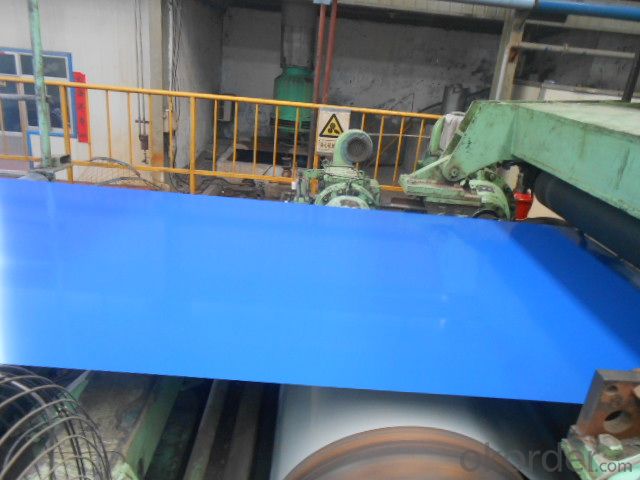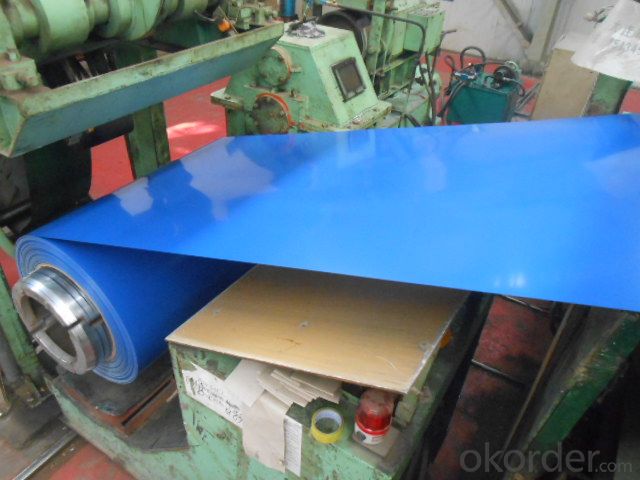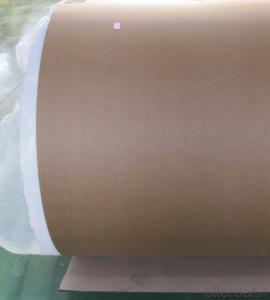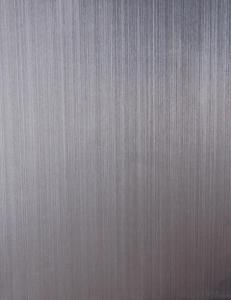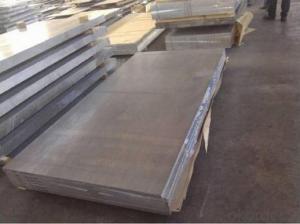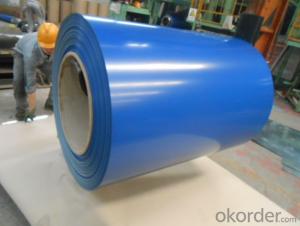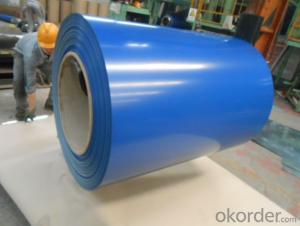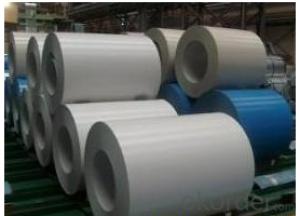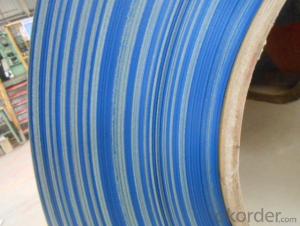PPGI, Pre-Painted Steel Coil Prime Quality Blue Color - Aluminum Sheets White
- Loading Port:
- Shanghai
- Payment Terms:
- TT OR LC
- Min Order Qty:
- 200 m.t.
- Supply Capability:
- 10000 m.t./month
OKorder Service Pledge
OKorder Financial Service
You Might Also Like
1.Structure of Pre-painted Galvanized/Aluzinc Steel Coil Description
With GI (aluzinc) as base metal, after pretreatment (degrease and chemical treatment) and liquid dope with several layers of color, then after firing and cooling, finally the plate steel is called pre-painted galvanized (aluzinc) steel. Pre-painted galvanized steel is good capable of decoration, molding, corrosion resistance. It generally displays workability, durability and weather resistance.
2.Main Features of the Pre-painted Galvanized/Aluzinc Steel Coil
• Excellent corrosion resistance
• Excellent weather resistance
• Capability of decoration, molding, corrosion resistance
• Workability, durability
• Excellent heat resistance performance
• High strength
• Good formability
• Good visual effect
3.Pre-painted Galvanized/Aluzinc Steel Coil Images
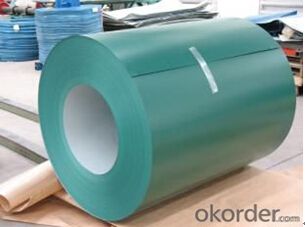
4.Pre-painted Galvanized/Aluzinc Steel Coil Specification
Quality standar: JIS G3312 CGCC & CGLCC
Hardness of P: Both soft and hard quality are available
Surface finish: with or without protect film
Thickness : 0.14-1.20 mm
Width : 914mm, 1000mm, 1220mm and 1250mm, thickness 600-1250mm is available
Finish by coil or sheet: Both sheet and coil are available
8Zinc coating: 60-275G/M2, both sides
Paint thickness for top side : 5 micron primer + (10-20) microns modified polyester, green color.
Paint thickness for back side: (5-10) microns Epoxy
Weight per coil: 4-6 tons, also can be upon customer's requirements
Max loading weight in one 20ft container : 25 tons generally
5. FAQ of Pre-painted Galvanized/Aluzinc Steel Coil
We have organized several common questions for our clients,may help you sincerely:
1. What is the minimum order quantity ?
Our MOQ is 50mt for each size. And we will consider to give more discount if you make big order like 1000 tons and more. Further more, the more appropriate payment term your offer the better price we can provide.
2. How long can we receive the product after purchase?
Usually within thirty working days after receiving buyer’s advance payment or LC. We will arrange the factory manufacturing as soon as possible. The cargo readiness usually takes 15-25 days, but the shipment will depend on the vessel situation.
3. How to guarantee the quality of the products?
We have established the international advanced quality management system,every link from raw material to final product we have strict quality test;We resolutely put an end to unqualified products flowing into the market. At the same time, we will provide necessary follow-up service assurance.
- Q: I have heard that consuming aluminum can increase your risk for Alzheimer's later in life.Knowing this, would it increase my risk to eat sweet potatoes cooked in aluminum foil?Even if there is a negligible risk, I still want to know for curiosity reasons.Thank You
- There okorder /... If you do need to use aluminum foil in an emergency, make sure the bright side it toward the food, and hopefully it is not long exposed or an acidic food. I've had aluminum foil dissolved by food. I also keep in mind the difference between consuming the metal, versus the natural occurring form. Don't you find it odd that it took the US government until 2012 to decide that Al was safe to add to table salt? Who influenced this? How can they decide it is not safe, then safe in other products? I hope this helps. Take care.
- Q: i heard that aluminum causes Alzheimers and i was wondering if there is any aluminum in tin.
- no, tin is tin it's one of the periodic elements.
- Q: Can the export quality of China's aluminum plate meet the requirement of ASTM B 209? Is this requirement for our country? Master the exhibitions, O (a _ U) O thank you
- ASTM B209 standards for aluminum materials developed by us Materials LaboratoryThe corresponding domestic standards for GB/T 3880, but 3880 standards in many places and B209 there are many differences, some domestic manufacturers can be produced in accordance with B209.
- Q: What are the different methods of surface treatment for adhesive bonding of aluminum sheet?
- Aluminum sheet adhesive bonding can be enhanced through various surface treatment methods. These methods aim to improve the strength and durability of the adhesive joint. Some commonly employed techniques include: 1. Enhancing mechanical interlock: One approach involves roughening the aluminum surface using sandblasting, abrasion, or wire brushing. This creates a stronger mechanical interlock between the adhesive and the aluminum, ultimately increasing bond strength. 2. Chemical treatment for surface improvement: Chemical treatments can eliminate contaminants, oxidation, or corrosion from the aluminum surface. Acid etching, chromate conversion coating, or anodizing are commonly used methods. These treatments enhance surface cleanliness and promote adhesion by creating a chemically reactive surface for the adhesive. 3. Plasma treatment: Exposing the aluminum surface to a low-temperature plasma discharge modifies the surface energy and eliminates contaminants. This treatment enhances the adhesive's wettability and adhesion. 4. Primer coating: Applying a primer coat on the aluminum surface facilitates chemical bonding between the adhesive and the substrate. Primers are designed specifically to enhance adhesion to certain substrates, thereby improving bond strength and durability. 5. Surface activation: Techniques like flame treatment or corona treatment can increase the surface energy of the aluminum sheet. These methods generate free radicals on the surface, thereby improving the adhesive's bonding characteristics. It's worth noting that the choice of surface treatment method depends on factors such as the specific adhesive used, desired bond strength, application requirements, and the condition of the aluminum surface. It is advisable to consult adhesive manufacturers or experts to determine the most suitable surface treatment method for a particular adhesive bonding application.
- Q: What is the bending radius of aluminum sheets?
- The bending radius of aluminum sheets depends on various factors such as the thickness of the sheet, the alloy of aluminum being used, and the type of bending process. Generally, aluminum sheets with a thickness of 1mm or less can be bent to a radius equal to the sheet thickness without cracking. For thicker aluminum sheets, the bending radius should be larger than the sheet thickness to avoid cracking or fracturing. As a general rule, the bending radius for aluminum sheets with a thickness between 1mm and 6mm should be at least 1.5 times the sheet thickness. For example, a 3mm thick aluminum sheet should have a minimum bending radius of 4.5mm. It is important to note that these guidelines are approximate and may vary depending on the specific alloy and temper of aluminum being used. Furthermore, different bending processes such as air bending, bottoming, or coining may require different bending radii. It is recommended to consult the manufacturer's specifications or seek professional advice for precise bending radius requirements for specific aluminum sheet applications.
- Q: Are the aluminum sheets suitable for automotive applications?
- Indeed, automotive applications can make use of aluminum sheets. Being a lightweight material with a high strength-to-weight ratio, aluminum proves to be an excellent choice for the automotive industry. Its attributes lend themselves well to this industry, offering numerous benefits such as enhanced fuel efficiency, improved handling, and increased performance. Furthermore, aluminum's resistance to corrosion is advantageous for automotive applications, as it contributes to the longevity of vehicles. Furthermore, aluminum sheets possess the ability to be easily shaped and molded into various forms, which grants automotive manufacturing greater design flexibility. In conclusion, the utilization of aluminum sheets in automotive applications has gained popularity due to their myriad advantages and their positive impact on vehicle performance and sustainability.
- Q: How does the purity of aluminum affect its properties as a sheet?
- The purity of aluminum greatly affects its properties as a sheet. Higher purity levels result in increased strength, improved corrosion resistance, and enhanced conductivity. Pure aluminum sheets are softer and more malleable, making them easier to form and shape. However, impurities can negatively impact these properties, reducing strength and increasing susceptibility to corrosion. Therefore, maintaining high purity levels is essential for achieving desired sheet properties and performance.
- Q: What are the different types of surface treatments available for marine-grade aluminum sheets?
- There are several types of surface treatments available for marine-grade aluminum sheets, including anodizing, powder coating, and painting. Anodizing involves creating a protective oxide layer on the surface of the aluminum, which enhances its corrosion resistance. Powder coating involves applying a dry powder to the surface, which is then heated to form a durable and protective coating. Painting is another option, where a layer of paint is applied to the aluminum surface to provide both aesthetic appeal and protection against corrosion.
- Q: Can aluminum sheets be used for electrical enclosures?
- Yes, aluminum sheets can be used for electrical enclosures. Aluminum is a widely used material in the electrical industry due to its excellent conductivity, lightweight nature, and corrosion resistance. It provides a durable and reliable solution for protecting electrical components and ensuring proper functioning of the enclosure.
- Q: Can aluminum sheets be used for insulation purposes?
- Yes, aluminum sheets can be used for insulation purposes. They have a low thermal conductivity and can effectively reflect heat and cold, making them suitable for insulating applications in various industries such as construction, automotive, and packaging.
Send your message to us
PPGI, Pre-Painted Steel Coil Prime Quality Blue Color - Aluminum Sheets White
- Loading Port:
- Shanghai
- Payment Terms:
- TT OR LC
- Min Order Qty:
- 200 m.t.
- Supply Capability:
- 10000 m.t./month
OKorder Service Pledge
OKorder Financial Service
Similar products
Hot products
Hot Searches
Related keywords




